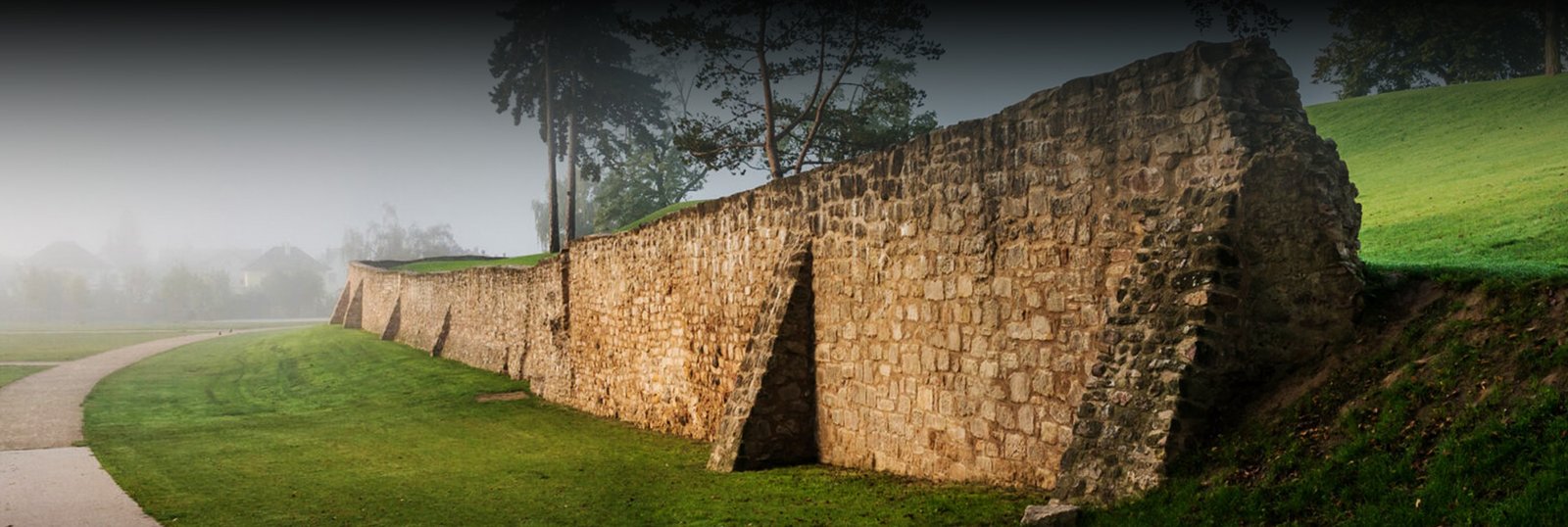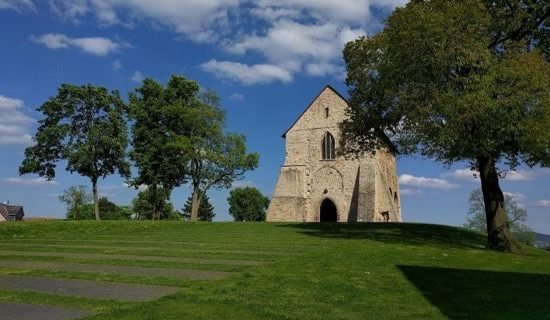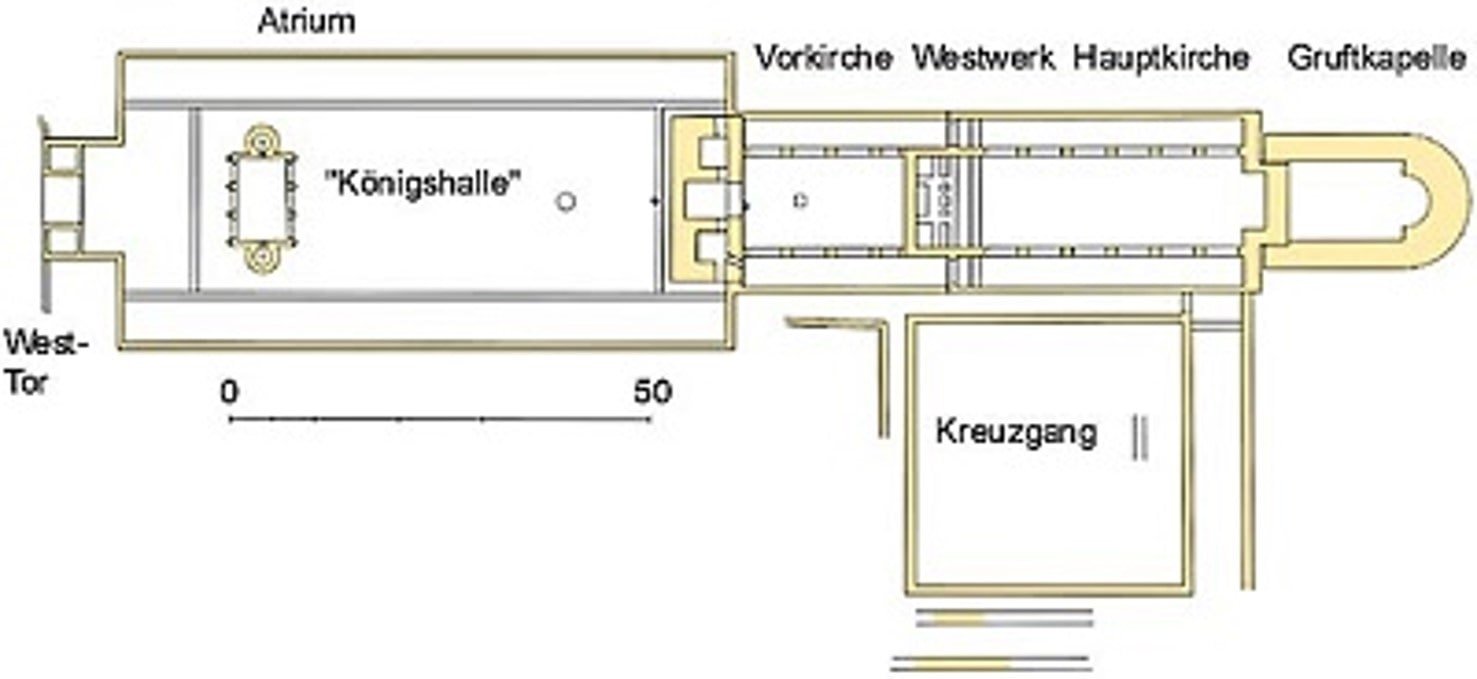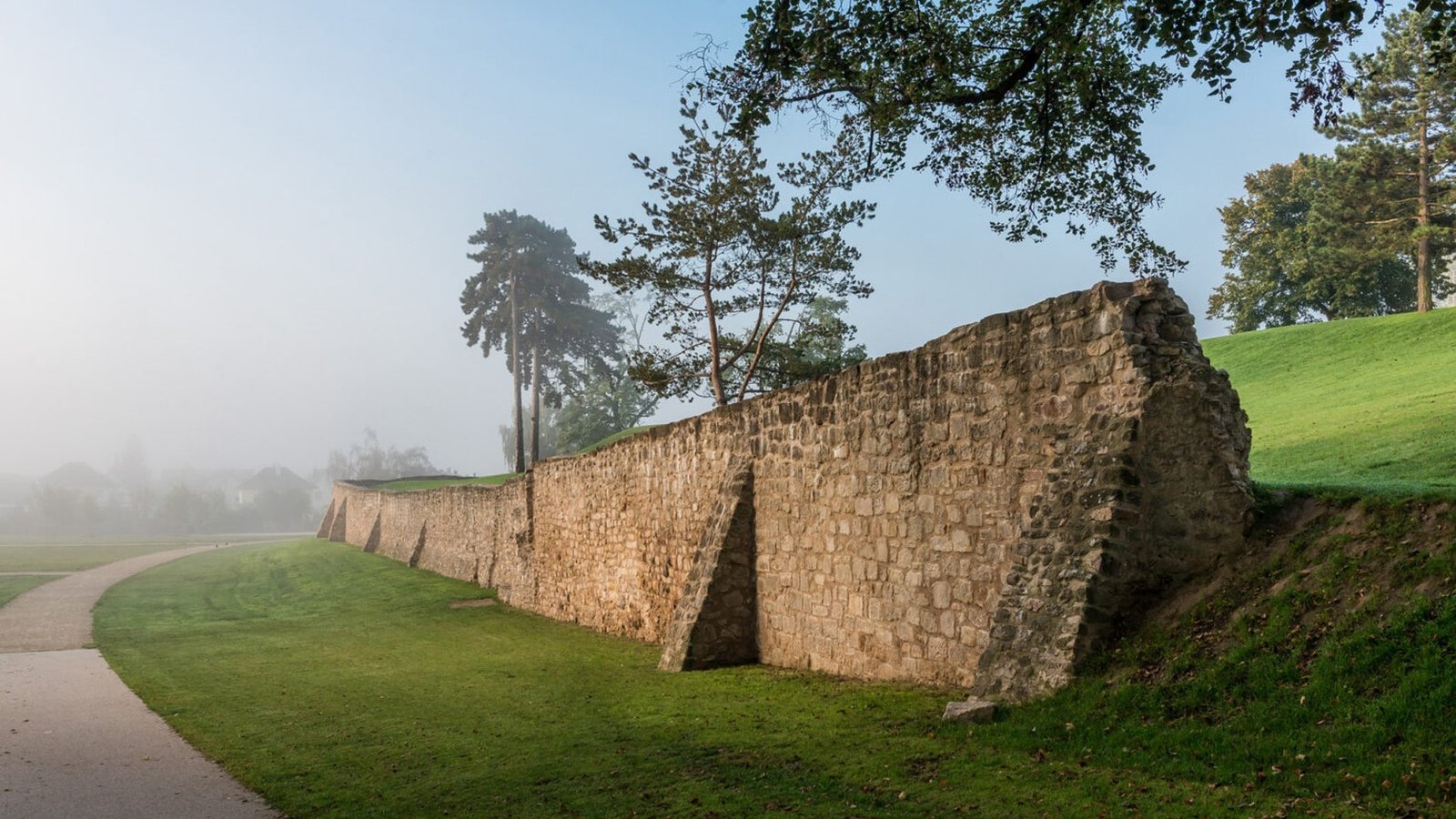Lorsch Abbey
per person
From the date it was originally founded in the Carolingian period up until the High Middle Ages, Lorsch Abbey was one of the most important cultural centres for the dissemination of the educational programme developed by the royal court. The abbey became famous for its scriptorium and comprehensive library, one of the largest and most important in the Middle Ages. Today, the remaining works, including the famous Codex Aureus of Lorsch, are dispersed across 54 sites in 17 countries around the world. The monastery was also a pioneer in the field of medicine. The late eighth century Lorsch Pharmacopeia is the oldest pharmaceutical manuscript of the Western Middle Ages. Lorsch Abbey is also mentioned in Germany’s well-known legend, the Song of the Nibelungs, as the burial site for Siegfried. Although the latter is only a legend, the monastery is the actual resting place of the first East Frankish Kings of the Carolingian dynasty.
FORMAL ANALYSIS
In 764, the Robertian family began establishing a small monastery between two arms of the Weschnitz River, which was later known as Altenmünster. Just three years afterwards, the establishment was moved to its new location. It became a royal abbey in 772 and was consecrated in 774 in the presence of King Charlemagne. Over the course of eight centuries, monks and clergymen came to gather here around the bones of St. Nazarius, which helped the abbey achieve great prosperity. Around 800, the abbey’s possessions and estates stretched over the area of six modern-day European states. The Lorsch Codex, one of Europe’s most important economic and historical source documents, contains the first mention of hundreds of cities and towns.
Probably only from the middle of the 10th century as a Benedictine abbey, it was granted imperial immediacy from 772 until it lost this status in 1232. Under the regiment of the Archbishop of Mainz and Prince-elector, Premonstratensian canons ran the abbey until the dissolution of the Lorsch provostship, which began in 1556. From its dissolution through to the mid-18th century, the complex almost completely disappeared. This led to the site being dominated by agriculture, and thereafter it became the grand residence of a master forestry warden.
The Lorsch Abbey is not only linked to the famous ‘Königshalle’ (King’s Hall), but also to a library that is largely preserved – albeit scattered worldwide. The library brought together all available knowledge about God and the world, and the contents of the library reflect the rich cosmos of medieval scholarship. The library is now accessible online at any time for those who are interested. The monastic archives, which are much more difficult to reconstruct, will become accessible to the general public in the near future. As thoroughly eloquent witnesses of the past centuries, the Schaudepot Zehntscheune (Exhibition Depot Tithe Barn) includes findings from more than 200 years of archaeological activity on the site. Today, our aim is to give this abandoned site a piece of its aura back, to present the relics of its past, to make the site’s meaning come alive, and to explore the site’s history. The World Heritage Site Lorsch Abbey is property of the State Administration for Palaces and Gardens of Hesse (Verwaltung der Staatlichen Schlösser und Gärten Hessen).
FLORIAN HARTMANN
- LORSCH ABBEY© PHOT. https://kloster-lorsch.de/klosterlorsch
- GROUNDPLAN OF THE ABBEY OF LORSCH©PLAN: Hermann Schefers, Landesamt für Denkmalpflege Hessen
- THE CHURCH RUINS© PHOT. https://de.wikipedia.org/wiki/Kloster_Lorsch#/media/ Datei:Kirchenfragment,_Kloster_Lorsch.jpg
- THE MONASTERY WALL© PHOT. https://www.schloesser-hessen.de/de/kloster-lorsch/geschichte
- THE KING’S HALL© PHOT. https://www.schloesser-hessen.de/de/kloster-lorsch/geschichte
- INSIDE OF THE KING’S HALL© PHOT. https://kloster-lorsch.de/klosterlorsch/gebaeude/torhalle
- FACADE DECORATION OF THE KING’S HALL© PHOT. https://kloster-lorsch.de/ klosterlorsch/gebaeude/torhalle
Tour Location
Lorsch Abbey
| Other monuments and places to visit | Schaudepot Zehntscheune (Exhibition Depot tithe Barn) Lorsch Parmacopeia herb garden The Peony Garden Freilichtlabor Lauresham (Laboratory for experimental archaeology) Altenmünster Monastery (UNESCO World Heritage) The historical town center |
| Natural Heritage | UNESCO Geopark with different cycling opportunities as well as running tracks Extensive forest at the western edge of the town. |
| Historical Recreations | |
| Festivals of Tourist Interest | Lorsch Abbey workshops Tobacco workshops St John’s Festival (in the run-up to Midsummer Day) “Lorscher Kerb” (City festival, 3rd weekend in September) |
| Fairs | Spring Market with the Bee and Poets‘ Festival and Peony Days (2nd or 3rd weekend in May) Blaues Weihnachtswunder Lorsch (Christmas market, 1st weekend in Advent) |
| Tourist Office | Yes (lorsch.de) |
| Specialized Guides | Yes |
| Guided visits | Yes |
| Accommodations | B&Bs, guesthouses or small hotels for your stay. The neighbouring towns also offer hotels to suit every budget − just 10 minutes away. |
| Restaurants | Yes |
| Craft | |
| Bibliography | |
| Videos | |
| Website | lorsch.de instagram.com |
| Monument or place to visit | Lorsch Abbey site |
| Style | Pre-romanesque / carolingian |
| Type | Monastic architecture |
| Epoch | Carolingian / 12th century |
| State of conservation | particially ruined state, although the “Königshalle” remained |
| Mailing address | Nibelungenstraße 32 D-64653 Lorsch Germany |
| Coordinates GPS | 49°39′13″N 8°34′11″E |
| Property, dependency | |
| Possibility of visits by the general public or only specialists | General public visits |
| Conservation needs | |
| Visiting hours and conditions | Museumszentrum* (no guided tour) Open all year, Tue.–Sun., 10 a.m.–5 p.m; except on: New Year‘s Day, Shrove Tuesday, Christmas Eve & New Years Eve GUIDED TOURS (public tours, no reservation required for 2 people or more; registration required for groups of 10 people or more) Königshalle (King’s Hall) Duration: approx. 30–45 min., every hour 11 a.m.–4 p.m. Mar.–Oct., Tue.–Sun.; Nov.–Feb., Sat. & Sun. Only BOOKABLE GUIDED TOURS (For 2+ people | reservation required) 1. World Heritage Site Lorsch Abbey (grounds & buildings) 2. Schaudepot Zehntscheune (Exhibition Depot Tithe Barn) Open Year-Round, Tue.–Sun. Duration: approx. 90 min. |
| Ticket amount | Access to the grounds of the UNESCO World Heritage Lorsch Abbey is free. The individual sites, tours and activities (see selection below) can only be visited with an entrance ticket. NO GUIDED TOURS: Museumszentrum: €3 | family ticket (2 adults + up to 4 children) €7 GUIDED TOURS (public tours): Königshalle (incl. museum admission) €6 | family ticket €14 Combined ticket for Königshalle (King‘s Hall) & Freilichtlabor Lauresham (Laboratory for Experimental Archeology): €10 GUIDED TOURS (bookableI): Groups €70 (up to 10 people), each additional person €7 | Groups (of 20 people or more) €6 p.p. |
| Research work in progress | |
| Accessibility | Good |
| Signaling if it is registered on the route | |
| Bibliography | Die Reichsabtei Lorsch. Festschrift zum Gedenken an ihre Stiftung 764, Bd. 1, hg. v. Archivdirektor a. D. Dr. Friedrich Knöpp, Darmstadt 1973. Die Reichsabtei Lorsch. Festschrift zum Gedenken an ihre Stiftung 764, Bd. 2, hg. v. Archivdirektor a. D. Dr. Friedrich Knöpp, Darmstadt 1977. Beiträge zur Geschichte des Klosters Lorsch, hg. v. Heimat- und Kulturverein Lorsch in Verbindung mit der Arbeitsgemeinschaft der Geschichts- und Heimatvereine im Kreis Bergstraße, Lorsch 1980. Aktuelle Forschungen zum ehemaligen Reichs- und Königskloster Lorsch, hg. v. Ingolf Ericsson und Markus Sanke, Darmstadt 2004. Kloster Lorsch. Vom Reichskloster Karls des Großen zum Weltkulturerbe der Menschheit, hg. v. Hessisches Landesmuseum Darmstadt und Verwaltung der Staatlichen Schlösser und Gärten Hessen, Petersberg 2011. |
| Videos | Youtube |
| Information websites | kloster-lorsch.de wikipedia.org de-de.facebook.com |
| Location | 64653 Lorsch, Hesse (Germany) |














